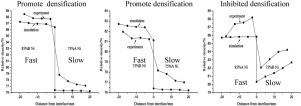Materials Today Communications ( IF 3.7 ) Pub Date : 2020-01-20 , DOI: 10.1016/j.mtcomm.2020.100943 Yongzhi Chen , Hao He , Yimin Li , Jia Lou , Lihua Wang , Rutie Liu , Zheyu He , Dongyang Li

|
In this study, the densification model for heterogeneous materials was established by using the viscoelastic flow theory to simulate density gradient distribution caused by interface stress. The densification process of co-sintering is the result of the joint action of the hydrostatic pressure of sintering and interfacial stress which is related to volume viscosity. The results show that the density distribution near the interface is more closely related to the densification rate at both ends than to the initial density. The side with fast densification rate applies compressive stress to the side with slow densification rate to promote its densification of the latter (The slower densification side). On the contrary, the side with slow densification rate should apply tensile stress to the side with fast densification rate to inhibit the former’s (The slower densification side) densification. To verify the criterion, two billets with different densification rates were used in the co-sintering experiment. Experimentally obtained density distribution of co-sintered samples is consistent with the model prediction.
中文翻译:

异质材料共烧结的致密化标准及其实验验证
本研究利用粘弹性流动理论建立界面应力引起的密度梯度分布,建立了非均质材料的致密化模型。共烧结的致密化过程是烧结的静水压力和界面应力共同作用的结果,这与体积粘度有关。结果表明,界面附近的密度分布与两端的致密化速率关系密切,而与初始密度无关。具有高致密化速率的一侧对具有低致密化速率的一侧施加压缩应力,以促进后者的致密化(较慢致密化一侧)。反之,致密化速率较慢的一侧应向致密化速率较快的一侧施加拉伸应力,以抑制前者(较慢的致密化一侧)的致密化。为了验证该标准,在共烧结实验中使用了两种具有不同致密化率的钢坯。实验获得的共烧结样品的密度分布与模型预测一致。









































 京公网安备 11010802027423号
京公网安备 11010802027423号